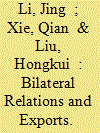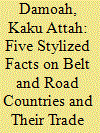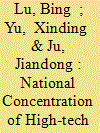|
|
|
Sort Order |
|
|
|
Items / Page
|
|
|
|
|
|
|
| Srl | Item |
| 1 |
ID:
190401


|
|
|
|
|
| Summary/Abstract |
This paper investigates the effect of bilateral relations on exports using data from Google Global Data. It finds that bilateral relations significantly reduced the negative effect of cultural distance on exports, indicating that they can promote exports by reducing trade costs. The paper finds that higher average Goldstein scores of events correlated with more exports and that bilateral relations had a larger effect on trust-intensive products, indicating that positive relations built trust and decreased the emotional distance between trading partners. The results also show that bilateral relations promoted exports at both the intensive and extensive margins but with a greater effect on the latter. Finally, bilateral relations had a greater positive effect on developing countries than on developed ones. The results were qualitatively unchanged when endogeneity issues and robustness concerns were considered.
|
|
|
|
|
|
|
|
|
|
|
|
|
|
|
|
| 2 |
ID:
190396


|
|
|
|
|
| Summary/Abstract |
China has a huge national interest in the success of the international effort to hold human-induced increases in temperature to 1.5 degrees – and therefore in global net emissions falling to net zero by 2050. China is essential to the success of the global effort – as a supplier of competitively priced equipment for the zero emissions world economy and as the world's largest current source of greenhouse gas emissions. Success is more likely for China and the world with international specialization in goods production for the zero emissions economy. This will require open international trade, with China supplying equipment and drawing zero emissions semi-processed goods from abroad. Success is more likely and will be achieved at a lower cost if there is close cooperation across national boundaries.
|
|
|
|
|
|
|
|
|
|
|
|
|
|
|
|
| 3 |
ID:
190399


|
|
|
|
|
| Summary/Abstract |
Different types of capital are better suited to financing technologies with different risk profiles, and structural matching between finance and technology may critically influence economic growth. Using cross-province panel data from China, we estimated the impact of the matching relationship between regions' financial structure and technology level on economic growth. We show that: (i) the matching relationship had a statistically significant positive impact on economic growth; (ii) structural mismatching reduced economic growth in comparison with the optimal matching point; (iii) structural matching better facilitated economic growth in more developed regions; and (iv) capital accumulation and technological progress were two of the main channels through which matching influenced economic growth. We address potential endogeneity concerns and perform robustness checks, and our results remain valid. Our findings provide convincing evidence for the optimal financial structure theory and explain China's rapid growth despite its comparatively underdeveloped securities market.
|
|
|
|
|
|
|
|
|
|
|
|
|
|
|
|
| 4 |
ID:
190400


|
|
|
|
|
| Summary/Abstract |
The Belt and Road Initiative (BRI) offers investment opportunities for several Eurasian countries but not all of them attract investments in the same way. This paper investigates the geographical distribution of BRI projects completed between 2013 and 2020. The analysis shows that pre-existing trade patterns are related to the likelihood of a country receiving completed BRI projects. We single out and provide evidence in support of five stylized facts. First, BRI countries with completed projects tend to be poorer and larger. Second, projects are more likely to occur in countries with intense intermediate trade with China. Third, the countries that received projects have more diversified export structures and their sectoral specialization overlaps with that of China. Fourth, among middle-high-income countries, the allocation of projects tends to favor those with high levels of intra-industry trade. Fifth, among BRI countries with projects, the complexity or sophistication of the goods traded increases faster with income. These findings suggest that fostering trade integration has direct benefits and may also contribute to further BRI investments.
|
|
|
|
|
|
|
|
|
|
|
|
|
|
|
|
| 5 |
ID:
190397


|
|
|
|
|
| Summary/Abstract |
This paper applies an endogenous institutionalist framework to understand the evolution of the rules-based international trading system since the end of World War II. We argue that the initial success of the General Agreement on Trade and Tariffs and re-enforcement that led to the formation of the WTO can be explained by three major factors: the hegemonic position of the US, the belief that international trade would foster prosperity and peace, and Cold War politics. However, declining US hegemony along with a shift in global comparative advantage in labor-intensive manufacturing led to a shift from multilateral towards preferential trade agreements since the 1990s. Today, the WTO faces several new challenges, including increasing geo-political competition between the US and China, increasing digitization of commerce, and disrupted supply chains following COVID-19. A functioning WTO that facilitates global economic re-integration remains crucial to ensure a strong recovery from the pandemic and continued long-term prosperity and stability of the global economy.
|
|
|
|
|
|
|
|
|
|
|
|
|
|
|
|
| 6 |
ID:
190398


|
|
|
|
|
| Summary/Abstract |
Based on the product-country level trade data from 2004 to 2017, as well as the High-Tech Products Catalog from the US Census Bureau, this paper examines empirically the current phenomenon of “national concentration” in high-tech exports. The results show that the phenomenon of “national concentration” not only exists but also tends to be self-reinforcing. Compared with other products, the exports of high-tech products tend to be concentrated in certain countries, and this concentration trends were further strengthened after the global financial crisis of 2008–2009. The national concentration of R&D activities may be one of the important causes of the national concentration of high-tech products. This pattern remains robust when we further use the value-added export data and different definitions of high-tech products. We argue that the phenomenon of “national concentration” of high-tech exports may herald the arrival of the “Second Great Divergence” – the divergence between innovative and manufacturing activities – in the global economy.
|
|
|
|
|
|
|
|
|
|
|
|
|
|
|
|
| 7 |
ID:
190394


|
|
|
|
|
| Summary/Abstract |
The structural changes that the Chinese economy has been experiencing since its working-age population began to decline pose challenges for its further growth. First, as it loses its comparative advantage in labor-intensive activities, the share of manufacturing in its GDP has shrunk. Second, unproductive enterprises that are reluctant to exit the market tend to seek policy protection, which leads to the immobility of resource allocation. Third, the reallocation of the labor force from the highly productive manufacturing sector to the low-productivity service sector leads to the degradation of resource allocation. The inadequate exploitation of the potential of resource reallocation implies that the decline in manufacturing is premature. It is therefore important to combine market competition policy, industrial policy, and social protection policy to stabilize the development of manufacturing.
|
|
|
|
|
|
|
|
|
|
|
|
|
|
|
|
| 8 |
ID:
190395


|
|
|
|
|
| Summary/Abstract |
This essay focuses on three broad sets of issues that may not slow China's GDP growth to under 3 percent a year, but they will almost certainly create major social and physical problems that will be difficult to deal with. The first is the demographic and education challenges featured by a rapidly aging population combined with a large share of the population being under-educated. The second is the environmental challenges China faces in achieving the state goal of carbon neutrality by 2060. The third challenge is low consumption and unprecedentedly high investment, a strategy that has driven China's high growth rates in the past decades but is no longer sustainable. These three challenges are intertwined, making China's adjustment path even more uncertain. What would a sustainable development strategy involve? The clearest need is to shift investment away from energy-intensive housing and infrastructure and toward investment in people.
|
|
|
|
|
|
|
|
|
|
|
|
|
|
|
|
|
|
|
|
|